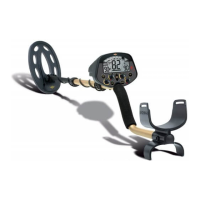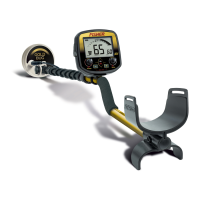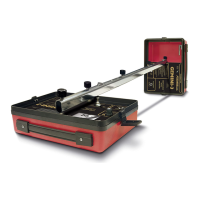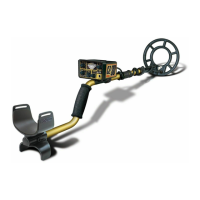CAPABILITIES AND LIMITATIONS (continued)
STEEL BOTTLE CAPS & FLAT IRON TRASH
Modern motion-type target ID metal detectors usually have difficulty consistently
identifying steel bottle caps and other flat iron trash objects. Double-D searchcoils also
have a reputation for having difficulty distinguishing steel bottle caps from coins, and for
being unable to eliminate steel bottle caps from detection. If you are searching in an area
where there are many steel bottle caps or other flat iron trash targets, minimize the amount
of unnecessary digging with the following methods:
1. Search with the 3b (bottle cap) process using the PROCESS # feature. This method
calculates visual ID differently in order to cause steel bottle caps to read lower on
the scale, and to register less consistently. A desirable object such as a coin will
usually produce numeric values that are fairly consistent in both directions of
sweep. See PROCESS # under the DISCRIMINATION Mode section of this
manual.
2. Search with the dP process. This method calculates visual ID differently in order to
cause steel bottle caps to ID lower on the scale and to register less consistently. It
also produces more audio clues to the character of the target.
3. Lift the searchcoil. Within 2 inches of a Bi-Axial searchcoil, the crossed magnetic
fields of the Double-D construction can produce anomalous responses. If the object
feels shallow (strong signal, narrow response, or multiple responses in a single
sweep) and is giving consistent high readings like a coin, raise the searchcoil 2 to 3
inches and try again. A coin will almost always continue to give consistent
readings unless it is right next to an iron object. A steel bottle cap that is at least 3
inches away from the searchcoil will usually produce readings that bounce around
from medium to low numbers.
4. Sweep the rear of the searchcoil over the center of the target, or sweep rapidly.
a. If the ID# is repeatable in the range of 68 to 72, when passing the center of
the searchcoil over the target at a normal speed, then the target is probably a
dime or copper penny.
b. If the ID# is not in the range of 68 to 72 then:
i. Sweep the back end of the searchcoil over the target. If tones change
from high to low, the target is probably a bottle cap.
ii. Sweep the center of the searchcoil rapidly across the target.
1. If tone and ID# drop, it is probably a bottle cap.
2. If a bottle cap, then the faster you sweep, the lower the tone.
5. Use the Confidence Indicator
Coins will usually produce a high confidence level, whereas steel bottle caps and
other trash will usually indicate a low or erratic confidence, even if the ID numbers
are consistently in the range of a coin. Confidence level is useful even if not using
the dP or 3b processes.
